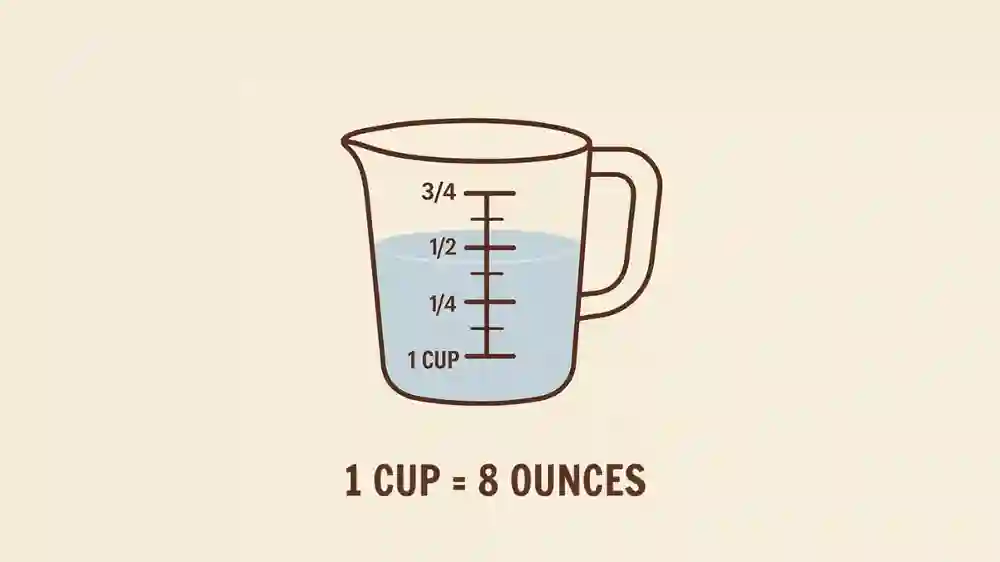Okay, so you’re standing in the kitchen, staring at that measuring cup like it’s some alien device. And the big question pops into your head: how many oz in a cup? Easy, right? Not quite.
I mean, I’ve been there. One time, I added eight ounces of milk thinking that was “a cup” — turns out I was measuring honey, and that was a sticky mess. Lesson learned: how many oz are in a cup depends on way more than just the number 8.
What’s the Deal with Ounces and Cups Anyway?
First off, ounces come in two flavors:
- Fluid ounces (volume)
- Dry ounces (weight)
Yeah, sounds like a riddle your grandma would ask over tea. But seriously, if you want to nail cooking and baking, you gotta know the difference.
So when people ask how many oz in a cup, what they usually mean is fluid ounces, like water or milk. That’s 8 fluid ounces in 1 US cup — pretty straightforward.
But dry ingredients? Now that’s a different story. Flour, sugar, stuff like that — their weight in ounces per cup changes because density is a fickle beast.
Flour, Sugar, and Other Dry Stuff: How Many Oz Is a Cup, Really?
Let me tell you a little secret: flour and sugar don’t play by the same rules.
One cup of flour weighs about 4.25 ounces. Sugar? Closer to 7 ounces. Brown sugar, the packed kind? Around 7.5 ounces.
My first herb garden died faster than my 2020 sourdough starter—RIP, Gary. Same goes for my baking attempts when I ignored weight and just guessed at cups. Spoiler: it was a disaster. Like, cake-in-a-pan-turned-concrete disaster.
Liquid Measurements: The Simple(ish) Part
Water, milk, juice — these are your friends. One cup equals 8 fluid ounces. Easy-peasy. I’ve spilled more milk than I care to admit, but at least I know the conversions now.
Oddly enough, oil is a bit sneaky. A cup of vegetable oil weighs about 7.7 ounces. Honey? It’s heavier than your Aunt Karen’s fruitcake at Christmas—1 cup weighs about 12 ounces. Who knew, right?
Quick Conversion Chart – Cups to Ounces (Because We All Forget)
| Cups | Fluid Ounces |
| 1/4 | 2 fl oz |
| 1/3 | 2.67 fl oz |
| 1/2 | 4 fl oz |
| 2/3 | 5.33 fl oz |
| 3/4 | 6 fl oz |
| 1 | 8 fl oz |
| 1.5 | 12 fl oz |
| 2 | 16 fl oz |
Keep this handy, y’all. Trust me — my first “how many oz in cup” crisis ended with soggy brownies and tears.
Why It Matters — More Than Just Kitchen Math
Anyway, here’s the kicker: if you’re baking, eyeballing the cup-to-ounce conversion will bite you in the butt. I learned the hard way when my cookies turned out flatter than my last Tinder date’s personality.
When recipes ask how many oz in a cup, they often assume you’re using liquid ounces. But I always double-check because the weight of dry ingredients can throw off everything.
The World’s Cup Problem: Not All Cups Are Created Equal
Here’s a fun twist — the “cup” you use depends on where you live.
- US cup = 8 fluid ounces (about 240 ml)
- UK cup = 10 imperial fluid ounces (about 284 ml)
- Australian cup = 8.45 fluid ounces (about 250 ml)
So if you’re following a British recipe and wondering how many oz is a cup, it’s not the same 8 you’re used to.
I remember trying to make a British pudding once. The cup size mix-up almost caused a kitchen flood. True story.
Measuring Tools: Pick Your Weapon Wisely
- Liquid measuring cups = glass or plastic, with a spout
- Dry measuring cups = stackable metal or plastic, no spout
- Kitchen scale = my secret weapon. Seriously.
That cracked watering can from Pete’s Hardware on 5th Ave survived my overwatering phase. It’s seen more mess than my measuring cups.
The “Wait, What?” Factor: Weight vs Volume
Here’s where folks get tripped up. Measuring sugar or flour in cups can vary a lot depending on how you scoop or pack it.
Example: 1 cup granulated sugar weighs about 7 ounces. But powdered sugar? Closer to 4 ounces.
You need nitrogen-rich soil—wait, no, was it potassium? Let me Google that again… same thing applies here. Density varies.
Remember This Cheat Sheet for Quick Answers
- 1 cup = 8 fl oz (liquid)
- 1/2 cup = 4 fl oz
- 1/4 cup = 2 fl oz
- 1/3 cup = 2.67 fl oz
If a recipe says “1 cup olive oil,” that’s about 7.7 oz, so don’t eyeball it unless you like surprises.
Other Cups You Might Be Using (Besides Measuring Cups)
Coffee cup? About 6 ounces. Teacup? 5 ounces. My mug? A wicked 12 ounces, usually filled with something way too strong.
So next time someone asks you how many oz in cup, make sure you’re not talking about their coffee cup from that dive bar downtown.
My Neighbor Tina and the Kale Cure
My neighbor Tina swears her kale patch cured her Zoom fatigue—and she’s not wrong. Anecdotal? Sure. But that’s the human side of measurement — you gotta know your tools and your plants.
Random Fun Fact for the Road
Victorians believed talking to ferns prevented madness. I talk to my begonias just in case.
Wrapping It Up (But Not Really)
So, to answer your burning question — how many oz in a cup?
It depends.
Liquids? 8 fl oz.
Dry ingredients? Depends on the ingredient and how you measure it.
International cups? Vary by country.
Your mug? Probably way more.
Keep this guide in your back pocket next time you’re staring at that measuring cup, wondering if you just ruined your cake or your dinner.


